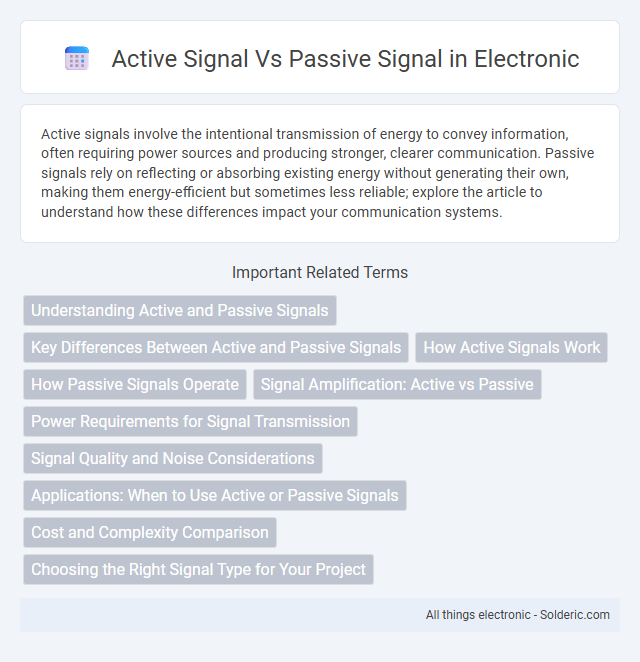Active signals involve the intentional transmission of energy to convey information, often requiring power sources and producing stronger, clearer communication. Passive signals rely on reflecting or absorbing existing energy without generating their own, making them energy-efficient but sometimes less reliable; explore the article to understand how these differences impact your communication systems.
Comparison Table
| Feature | Active Signal | Passive Signal |
|---|---|---|
| Definition | Signal generated and transmitted with power from a source | Signal received or reflected without additional power |
| Power Source | Requires external power or internal energy | No power required, relies on existing signals |
| Signal Strength | Generally strong and controlled | Weaker and dependent on environment |
| Usage Examples | Radar, active sensors, communication transmitters | Passive RFID, ambient signal detection, natural light sensors |
| Cost | Higher due to power and active components | Lower, simpler design without power |
| Complexity | More complex circuitry and maintenance | Simple, less maintenance involved |
| Range | Longer range due to amplified output | Shorter range influenced by ambient factors |
| Signal Quality | Consistent and reliable signal | Variable, influenced by external interference |
Understanding Active and Passive Signals
Active signals generate their own energy, allowing them to transmit data over longer distances with higher accuracy and less interference, commonly used in devices like Bluetooth and radar systems. Passive signals rely on external energy sources, often resulting in lower power consumption but limited range and sensitivity, typical in RFID tags and certain types of antennas. Understanding the differences helps you choose the right technology for applications requiring either power efficiency or signal strength.
Key Differences Between Active and Passive Signals
Active signals generate their own power through a source such as a transmitter or amplifier, enabling longer transmission distances and better noise resistance. Passive signals rely solely on external power sources or environmental energy and often degrade over distance due to signal attenuation. Key differences include signal strength consistency, dependence on power sources, and overall transmission quality.
How Active Signals Work
Active signals operate by generating their own energy source, which allows the device to send or transmit data without relying on external power or light sources. Common examples include radar, sonar, and certain types of remote controls that emit electromagnetic waves or sound pulses to detect objects or communicate information. This self-generated signal enhances accuracy and range as it can be controlled and modulated for specific detection or transmission tasks.
How Passive Signals Operate
Passive signals operate by reflecting existing energy or signals from the environment without generating their own. They rely on external sources, such as ambient light or sound waves, to provide information that is then detected and measured. Your ability to interpret passive signals depends on the quality and nature of these external stimuli, making them energy-efficient but sometimes less reliable than active signals.
Signal Amplification: Active vs Passive
Active signals involve signal amplification through electronic components that boost the signal strength, ensuring a stronger and clearer transmission over longer distances. Passive signals rely on the original signal's power without any amplification, which can lead to signal degradation and reduced range. Active signal systems are essential in applications requiring high fidelity and extended coverage, while passive systems are typically simpler and suitable for short-distance or low-power scenarios.
Power Requirements for Signal Transmission
Active signals require external power sources to amplify and transmit data over longer distances with minimal loss, ensuring consistent signal strength. Passive signals, in contrast, rely on the inherent power of the source and experience attenuation as they travel, limiting their effective transmission range. Understanding these power requirements helps you choose the right signal type for efficient and reliable communication in various applications.
Signal Quality and Noise Considerations
Active signals utilize powered devices to amplify and transmit data, resulting in improved signal quality and reduced noise interference over long distances. Passive signals rely on unpowered transmission paths, making them more susceptible to signal degradation and external noise, especially in electrically noisy environments. Choosing active signal systems enhances reliability and clarity in data transmission by maintaining stronger signal levels and minimizing noise impact.
Applications: When to Use Active or Passive Signals
Active signals are ideal for applications requiring long-distance transmission or environments with high electrical noise, such as industrial automation and telecommunications, where signal amplification ensures clarity and strength. Passive signals suit short-distance or low-power needs, including basic sensor data or simple audio setups, where minimal energy consumption and simplicity are priorities. Your choice depends on factors like distance, power availability, and the necessity for signal integrity.
Cost and Complexity Comparison
Active signal systems typically involve higher costs due to the need for powered components such as amplifiers and active sensors, increasing both initial investment and maintenance expenses. Passive signal systems offer lower complexity and cost because they rely on unpowered elements like resistors, capacitors, or inductors, reducing wiring and energy requirements. Choosing between active and passive signals depends on budget constraints and the desired level of signal conditioning and system sophistication.
Choosing the Right Signal Type for Your Project
Selecting the right signal type for your project depends on the specific requirements and constraints of your application. Active signals provide a stronger, amplified output useful for long-distance transmission or environments with high interference, ensuring clear and reliable data. Passive signals require no external power, making them ideal for simple, low-power setups where cost and energy efficiency are priorities.
active signal vs passive signal Infographic

 solderic.com
solderic.com